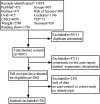Epidemiological and clinical characteristics of vaccinated COVID-19 patients: A meta-analysis and systematic review
- PMID: 36412572
- PMCID: PMC9692180
- DOI: 10.1177/03946320221141802
Epidemiological and clinical characteristics of vaccinated COVID-19 patients: A meta-analysis and systematic review
Abstract
Objective: With the global epidemic of coronavirus disease 2019 (COVID-19), vaccination rates are increasing globally. This study evaluated the relevant clinical manifestations of vaccinated COVID-19 patients.
Methods: We searched carefully in 11 databases such as PubMed, Embase, Scopus, Cochrane Library, Web of Science, Ovid, China National Knowledge Infrastructure Database, Wan Fang Data, Sinomed, VIP Database, and Reading Showing Database up to 26 March 2022. To search for articles that have described the characteristics of vaccinated patients including epidemiological and clinical symptoms. Statistical analysis of the extracted data using STATA 14.0.
Results: A total of 58 articles and 263,708 laboratory-confirmed COVID-19 patients were included. Most of the patients in the vaccinated group had more asymptomatic infection and fewer severe illnesses. There were significant differences in ethnicity, and strain infected with COVID-19, and comorbidities (hyperlipidemia, diabetes, obesity, kidney disease, immunocompromised, cardiovascular disease, and tumor) and symptoms (fever, cough, gastrointestinal symptoms, neurological symptoms, and dysgeusia/anosmia) between vaccinated group and unvaccinated group. Oxygen support, use of steroid, days in hospital, hospital treatment, ICU treatment, death, and poor prognosis were also significantly different.
Conclusion: Compared with the vaccinated group, patients in the unvaccinated group had a more severe clinical manifestations. Vaccines are also protective for infected people.
Keywords: COVID-19; clinical characteristics; epidemiological characteristics; meta-analysis; vaccine.
Conflict of interest statement
The author(s) declared no potential conflicts of interest with respect to the research, authorship, and/or publication of this article.
Figures
Similar articles
-
[Influence of SARS-CoV-2 vaccination on the epidemiological and clinical characteristics of imported COVID-19 cases in Chengdu].Zhonghua Liu Xing Bing Xue Za Zhi. 2021 Aug 10;42(8):1365-1370. doi: 10.3760/cma.j.cn112338-20210330-00261. Zhonghua Liu Xing Bing Xue Za Zhi. 2021. PMID: 34814555 Chinese.
-
Clinical manifestations of death with severe fever and thrombocytopenia syndrome: A meta-analysis and systematic review.J Med Virol. 2021 Jun;93(6):3960-3968. doi: 10.1002/jmv.26518. Epub 2020 Sep 30. J Med Virol. 2021. PMID: 32930400
-
Epidemiological and clinical characteristics of death from hemorrhagic fever with renal syndrome: a meta-analysis.Front Microbiol. 2024 Apr 4;15:1329683. doi: 10.3389/fmicb.2024.1329683. eCollection 2024. Front Microbiol. 2024. PMID: 38638893 Free PMC article.
-
Clinical manifestations of COVID-19 breakthrough infections: A systematic review and meta-analysis.J Med Virol. 2022 Sep;94(9):4234-4245. doi: 10.1002/jmv.27871. Epub 2022 Jun 1. J Med Virol. 2022. PMID: 35588301 Free PMC article.
-
Clinical features and corresponding immune function status of recurrent viral polymerase chain reaction positivity in patients with COVID-19 : A meta- analysis and systematic review.Int J Immunopathol Pharmacol. 2021 Jan-Dec;35:20587384211027679. doi: 10.1177/20587384211027679. Int J Immunopathol Pharmacol. 2021. PMID: 34162269 Free PMC article.
Cited by
-
Longitudinal fecal shedding of SARS-CoV-2, pepper mild mottle virus, and human mitochondrial DNA in COVID-19 patients.Front Med (Lausanne). 2024 Sep 11;11:1417967. doi: 10.3389/fmed.2024.1417967. eCollection 2024. Front Med (Lausanne). 2024. PMID: 39323476 Free PMC article.
-
Specific and Non-specific Aspects and Future Challenges of ICU Care Among COVID-19 Patients with Obesity: A Narrative Review.Curr Obes Rep. 2024 Sep;13(3):545-563. doi: 10.1007/s13679-024-00562-3. Epub 2024 Apr 4. Curr Obes Rep. 2024. PMID: 38573465 Review.
-
Diagnostic accuracy of clinical signs and symptoms of COVID-19: A systematic review and meta-analysis to investigate the different estimates in a different stage of the pandemic outbreak.J Glob Health. 2023 Jul 14;13:06026. doi: 10.7189/jogh.13.06026. J Glob Health. 2023. PMID: 37441773 Free PMC article.
-
Olfactory Epithelium Infection by SARS-CoV-2: Possible Neuroinflammatory Consequences of COVID-19.Complex Psychiatry. 2024 Oct 15;10(1-4):59-70. doi: 10.1159/000540982. eCollection 2024 Jan-Dec. Complex Psychiatry. 2024. PMID: 39545135 Free PMC article. Review.
References
-
- WHO Coronavirus (COVID-19) Dashboard . (2022), https://covid19.who.int (acceseed 2022-8-25).
Publication types
MeSH terms
LinkOut - more resources
Full Text Sources
Medical


